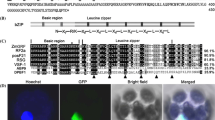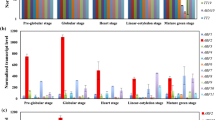Abstract
C2H2 zinc-finger proteins play important roles in plant development including floral organogenesis, leaf initiation, lateral shoot initiation, gametogenesis and seed development. The gene for one such protein from Arabidopsis, AtZFP1 (Arabidopsis thalianazinc-finger protein 1), is expressed at high levels in the shoot apex, including the apical meristem, developing leaves and the developing vascular system. In light-grown seedlings, AtZFP1 expression is induced about three days after germination, before the expansion of the true leaves. Dark-grown plants, in which photomorphogenesis is repressed, have no detectable AtZFP1 expression in the shoot apex. Under conditions which induce or mimic photomorphogenic development including growth in the light, shifting dark-grown plants to continuous light or growth on cytokinin in the dark, high levels of AtZFP1 expression are detected. Furthermore, AtZFP1 expression does not depend on active photosynthesis as shown by analysis of plants grown on the carotenoid biosynthetic inhibitor norflurazon. These results are discussed in relation to a possible role for AtZFP1 in shoot development, downstream of photomorphogenic activation.
Similar content being viewed by others
References
Barrieu, F., Chaumont, F. and Chrispeels, M.J. 1998. High expression of the tonoplast aquaporin ZmTIP1 in epidermal and conducting tissues of maize. Plant Physiol. 117: 1153–1163.
Barton, M.K. and Poethig, R.S. 1993. Formation of the shoot apical meristem in Arabidopsis thaliana: an analysis of development in the wild type and in the shoot meristemless mutant. Development 119: 823–831.
Bechtold, N., Ellis, J. and Pelletier, G. 1993. In planta Agrobacterium mediated gene transfer by infiltration of adult Arabidopsis thaliana plants. C. R. Acad. Sci. Paris, Life Sci. 316: 1194–1199.
Bowman, J.L., Sakai, H., Jack, T., Weigel, D., Mayer, U. and Meyerowitz, E.M. 1992. SUPERMAN, a regulator of floral homeotic genes in Arabidopsis. Development 114: 599–615.
Chaudhury, A., Ming, L., Miller, C., Craig, S., Es, D. and Peacock, W. 1997. Fertilization-independent seed development in Arabidopsis thaliana. Proc. Natl. Acad. Sci. USA 94: 4223–4228.
Chory, J., Reinecke, D., Sim, S., Washburn, T. and Brenner, M. 1994. A role for cytokinins in de-etiolation in Arabidopsis. Plant Physiol. 104: 339–347.
Church, G.M. and Gilbert, W. 1984. Genomic sequencing. Proc. Natl. Acad. Sci. USA 81: 1991–1995.
Clark, S.E. 1997. Organ formation at the vegetative shoot meristem. Plant Cell 9: 1067–1076.
Colasanti, J., Yuan, Z. and Sundaresan, V. 1998. The indeterminate gene encodes a zinc finger protein and regulates a leaf-generated signal required for the transition to flowering in maize. Cell 93: 593–603.
Coleman, J.E. 1992. Zinc proteins: enzymes, storage proteins, transcription factors, and replication proteins. Annu. Rev. Biochem. 61: 897–946.
Culp, A.M. 1998. DNA-binding characteristics of a Cys2His2 zinc finger protein of Arabidopsis thaliana. Master's thesis, Department of Biology, Wake Forest University, Winston-Salem, NC.
Gaiser, J.C., Robinson-Beers, K. and Gasser, C.S. 1995. The Arabidopsis SUPERMAN gene mediates asymmetric growth of the outer integument of ovules. Plant Cell. 7: 333–345.
Gallagher, S.R. 1992. Quantitation of GUS activity by fluorometry. In: S.R. Gallagher (Ed.), GUS Protocols: Using the GUS Gene as a Reporter of Gene Expression, Academic Press, New York, pp. 47–59.
Jabben, M. and Deitzer, G.F. 1978. A method for measuring phytochrome in plants grown in white light. Photochem. Photobiol. 27: 799–802.
Kobayashi, A., Sakamoto, A., Kubo, K., Rybka, Z., Kanno, Y. and Takatsuji, H. 1998. Seven zinc-finger transcription factors are expressed sequentially during the development of anthers in petunia. Plant J. 13: 571–573.
Lowry, O.H., Rosebrough, N.J., Farr, A.L. and Randall, R.J. 1951. Protein measurement with the Folin phenol reagent. J. Biol. Chem. 193: 265–275.
Luo, M., Bilodeau, P., Koltunow, A., Dennis, E.S., Peacock, W.J. and Chaudhury, A.M. 1999. Genes controlling fertilizationindependent seed development in Arabidopsis thaliana. Proc. Natl. Acad. Sci. USA 96: 296–301.
Martin, T., Wohner, R.-V., Hummel, S., Willmitzer, L. and Frommer, W.B. 1992. The GUS reporter system as a tool to study plant gene expression. In: S.R. Gallagher (Ed.), GUS Protocols: Using the GUS Gene as a Reporter of Gene Expression, Academic Press, New York, pp. 23–43.
Nelson, T. and Dengler, N. 1997. Leaf vascular pattern formation. Plant Cell 9: 1121–1135.
Poethig, R.S. 1997. Leaf morphogenesis in flowering plants. Plant Cell 9: 1077–1087.
Prigge, M. and Meeks-Wagner, D.R. 1998. SERRATE encodes a zinc finger protein required for normal shoot meristem function and leaf development. Abstracts of the 9th International Conference on Arabidopsis Research, June 1998.
Pylatuik, J.D., Bonham-Smith, P.C. and Davis, A.R. 1998. The additional stamens of flo10-1 mutants of Arabidopsis thaliana are compromised in production and viability of pollen. Can. J. Bot. 76: 1733–1742.
Relichova, J. 1976. Some new mutants. Arabidopsis Info. Serv. 13: 25–28.
Riechmann, J.L., Krizek, B.A. and Meyerowitz, E.M. 1996. Dimerization specificity of Arabidopsis MADS domain homeotic proteins Apetala1, Apetala3, Pistillata, and Agamous. Proc. Natl. Acad. Sci. USA 93: 4793–4798.
Sakai, H., Medrano, L.J. and Meyerowitz, E.M. 1995. Role of SUPERMAN in maintaining Arabidopsis floral whorl boundaries. Nature 378: 199–202.
Sinha, N. 1999. Leaf development in angiosperms. Annu. Rev. Plant Physiol. Plant Mol. Biol. 50: 419–446.
Su, W. and Howell, S.H. 1995. The effects of cytokinin and light on hypocotyl elongation in Arabidopsis seedlings are independent and additive. Plant Physiol. 108: 1423–1430.
Tague, B.W., Gallant, P. and Goodman, H.M. 1997. Expression analysis of an Arabidopsis C2H2 zinc finger protein gene. Plant Mol. Biol. 32: 785–796.
Tague, B.W. and Goodman, H.M. 1995. Characterization of a family of Arabidopsis zinc finger protein cDNAs. Plant Mol. Biol. 28: 267–279.
Takatsuji, H. 1998. Zinc-finger transcription factors in plants. Cell. Mol. Life Sci. 54: 582–596.
Takatsuji, H. 1999. Zinc-finger proteins: the classical zinc finger emerges in contemporary plant science. Plant Mol. Biol. 39: 1073–1078.
von Arnim, A. and Deng, X.-W. 1996. Light control of seedling development. Annu. Rev. Plant Physiol. Plant Mol. Biol. 47: 215–243.
Author information
Authors and Affiliations
Rights and permissions
About this article
Cite this article
Chrispeels, H.E., Oettinger, H., Janvier, N. et al. AtZFP1, encoding Arabidopsis thaliana C2H2 zinc-finger protein 1, is expressed downstream of photomorphogenic activation. Plant Mol Biol 42, 279–290 (2000). https://doi.org/10.1023/A:1006352809700
Issue Date:
DOI: https://doi.org/10.1023/A:1006352809700




